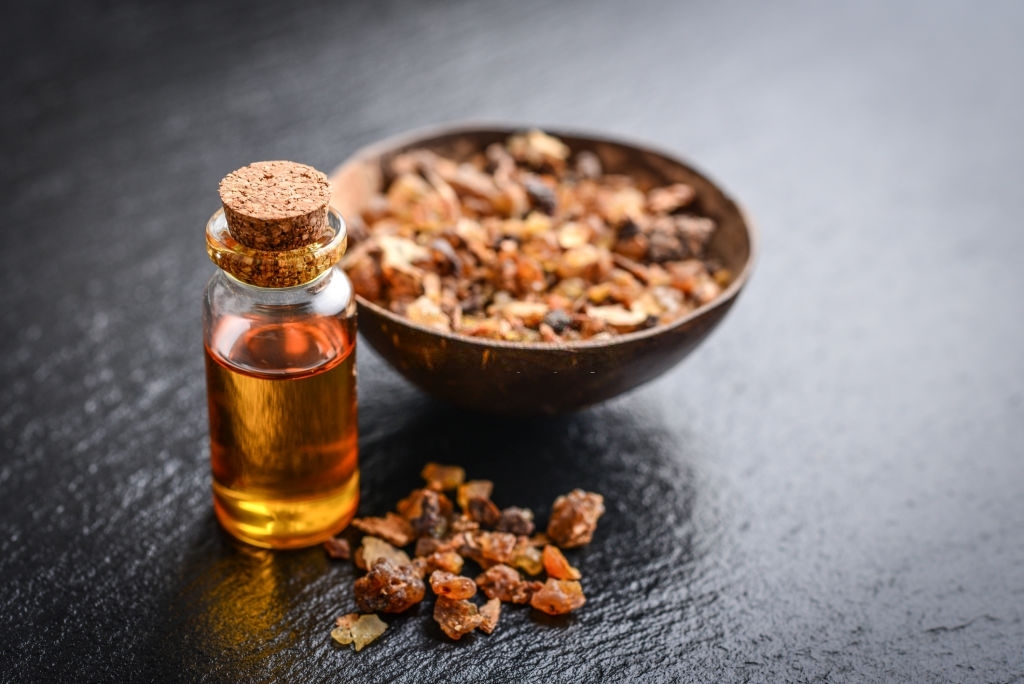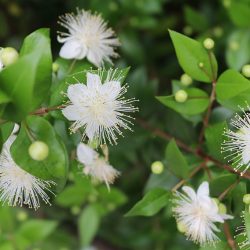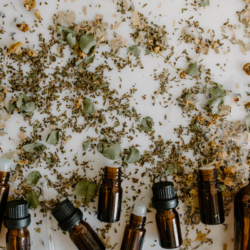Myrrh, an age-old plant treasure, continues to captivate the world with its unique properties and fascinating history. This article explores the many facets of this precious resin, from its botanical extraction to its ancient and modern uses.
Extracted from the Commiphora myrrha tree, a member of the Burseraceae family, myrrh is obtained from the gum-resin that runs off its bark. Once dissolved and distilled, this substance reveals an essential oil with a pungent odour, steeped in history and symbolism.
From ancient times to the present day, myrrh has been used across the ages and by different civilisations. From Egyptian religious rituals to the medicinal practices of ancient Greece, it has been a key component in a variety of cultures. Its history is closely linked to that of the Christian religion, where it is mentioned in numerous sacred texts, including the Bible.
Myrrh also has a mythological and cultural dimension. According to Greek mythology, it symbolises the tears of Horus and even has a divine origin, being linked to the goddess Aphrodite. This fragrant resin was used by the Greeks to flavour their wine, illustrating its role in everyday life and ceremonies.
But beyond its rich history, myrrh has remarkable pharmacological properties. Anti-inflammatory, analgesic and antimicrobial, its effects on health are diverse and have aroused growing medical interest. Today, myrrh essential oil is being studied for its many potential applications, from improving oral health to combating certain types of cancer.
This article will also detail the methods of using myrrh and the precautions to be taken, particularly with regard to its use in aromatherapy and natural medicine. Finally, we will explore recent scientific advances and clinical studies that highlight the importance and relevance of myrrh in the contemporary medical context.
History of Myrrh
Described as precious drugs, myrrh and frankincense are used for fumigation, luxurious embalming, anointing and other liturgical rituals, appearing in papyrus, the Vedas, the Koran and many other important writings.
A little Greek mythology
Although, according to Greek mythology, the Egyptians saw myrrh as symbolising the tears of Horus, myrrh was born of Myrrha’ s incestuous relationship with her father Cinyrus. It was the goddess Aphrodite who, jealous of the young girl’s beauty, breathed into her the inept idea of incest. When her father realised the error of his ways, he went after her to kill her. Imploring the gods to spare her, they transformed her into a myrrh tree, with tears of fragrant resin.
The Greeks made great use of myrrh, even using it to perfume their wine. Poseidon is associated with the smoking of myrrh in the prayer dedicated to him in the Orphic Hymns.
On the other side of the Mediterranean, the Greeks also set great store by myrrh. As they still do today with retsina, a white wine laced with pine resin, they mixed myrrh into the wine. Democritus mentions the existence, in the 5th century BC, of hermesias, a mixture of saffron, honey, crushed pine nuts, milk and palm wine. It was recommended “to be drunk before procreation, after conception and by nursing mothers in order to produce children remarkable for their spiritual gifts and beauty”
In the Christian religion
A sacred tree mentioned in the Bible, in the same way as frankincense, myrrh was given to the tortured by the Romans to ease their suffering. Myrrh was burnt in censers by the Egyptians, Greeks, Romans and Christians. It was used to embalm corpses to make mummies. The Lord had given Moses the formula for the sacred perfumes to be burnt in the temples. The Magi offered tears of myrrh to the infant Jesus.
Commonly burnt during religious services to honour the divinities, myrrh shines in the Song of Songs, where it is mentioned no less than seven times! It seems to be heavily charged with eroticism, as the following passage suggests: “My beloved is a sachet of myrrh that rests between my breasts” Knowing that myrrh is an anaphrodisiac, it’s probably a good idea not to take this allegation literally, but rather to see it as a reference to Christ’s love, even if this is doubtful. However, the Great Magic Papyrus of Paris speaks of myrrh in a rather similar sense when it says: “You are myrrh, bitter myrrh, strong myrrh [not to be confused with sweet myrrh, i.e. bdellium or opopanax], that which pacifies combatants, you who dry up and force to love those who do not know Eros “..
Some people describe the fragrance of myrrh essential oil as having a “hospital smell”, which is not contradicted by the slightly “cool”, if not “cold”, atmosphere it can produce when fumigated, as well as by the mushroomy, undergrowth and humus-like scent of this essential oil. Despite this, myrrh, perhaps more than frankincense, is truly the oil of the mystic, arousing meditation, contemplation and religious admiration.
In ancient times
During the time of Pharaonic Egypt, myrrh tears were in such demand that they functioned as a form of currency, particularly in exchange for precious stones. The ancients believed that they had powers over both the etheric and astral bodies.
The Queen of Sheba was also a very prosperous trader in essential myrrh oil, more than a thousand years before our era.
Nearly thirty-five centuries ago, the Egyptian queen Hatshepsut organised expeditions to the Somali coast to import gold, ebony, ivory and animals, but above all myrrh, the resinous gum that can naturally exude from a small shrub commonly known as the myrrh tree.
The history of myrrh is as old as that of incense. The Egyptians have known about it for four millennia and used it as one of the ingredients in kyphi. It was also used in embalming. According to Herodotus, the young Phoenix embalmed his father’s body in a myrrh egg.
In ancient Egypt, myrrh was ritually incinerated every evening and was an integral part of the composition of kyphi, a sacred Egyptian perfume. According to Plutarch, this complex mixture consisted of sixteen different ingredients: honey, wine, grapes, nutsedge, resin, myrrh, aspalathos, seselis, lentisk, bitumen, rush and patience, to which juniper berries, cardamom and calamus were added. The ingredients were not mixed randomly, but according to sacred recipes that were read to the perfumers during preparation
The antifungal and bactericidal effects of myrrh were also of great interest to Egyptian embalmers. The plant material in myrrh played a crucial role in Egyptian embalming rituals, abundantly impregnating the strips used. Given this close association with death, it is not surprising that the Egyptians favoured myrrh as an embalming agent, a practice confirmed by the subsequent presence of this substance in numerous sarcophagi. Myrrh is therefore linked “to nocturnal energy, darkness and death, as it was used to embalm the dead in order to ensure their eternal life in the land of the setting sun”
What’s more, when the Egyptians celebrated their dead at banquets, they rubbed an ointment scented with myrrh into their scalps, while the Hebrews mixed it with wine to obtain a sedative drink that was administered to the dying to ease their suffering.
This mortuary symbolism is echoed in the image of the phoenix, which “uses myrrh and incense […] to build its nest, and even carries them, before burning itself out on the pyre it has set up by piling up perfumed substances of all kinds”
In the Middle Ages
In Greek medicine in the first century, Dioscorides recommended applying a mixture of myrrh and vinegar to the temples and head to combat pain. In Arab-Persian medicine, Rhazes (10th century) recommended it for kidney and bladder complaints, pains in the womb and joints, and to expel intestinal worms. Avicenna (11th century) states that it heals bleeding wounds, prevents putrefaction and relieves pain. Mixed with milk, it can be used as an eyewash to treat corneal ulcers(Ibn al-Baytar, 13th century).
From the Renaissance to the present day
In France, it is renowned for its balsamic, emmenagogue, stimulant and antispasmodic properties. It is used to treat mouth and throat ailments. It was used in the composition of medicines such as Garrus and Fioraventi’s alcoholate or the balsamic tincture (Codex 1937).
Since the Renaissance, myrrh has been distilled to produce perfumes.
Although the therapeutic use of myrrh has fallen into relative disuse, the fact remains that it has long enjoyed the status it enjoys today.
What are the pharmacological properties of Bitter Myrrh resin essential oil?
Anti-inflammatory, analgesic and antioxidant effects:
The resin has a pain-relieving action comparable to that of morphine in the hot plate and writhing test; furanoeudesma-1,3-diene and curzerenone, isolated from the resin, bind to opioid receptors in particular and are therefore the active ingredients in the major analgesic effect.
An anti-inflammatory, myrrh essential oil blocks interleukin 1.
Antimicrobial effect:
Sesquiterpenes have antibacterial activity against pathogens such as Staphylococcus aureus, Pseudomonas aeruginosa and Escherichia spp. They also have effective antifungal properties against Candida albicans. The essential oil is antiviral.
Other effects:
- It has a calming effect and is endocrine
- Hormone-like (thyroid-modulating, anaphrodisiac)
- Anti-degenerative
- Sclerosing
- Immunostimulant (viruses)
- Helps accelerate the skin healing process
- Central action on rhythms :
- Reordering
- Internal restructuring (physical, biological, immune, emotional and psychological)
- Harmonises the central nervous system
- Anti-cancer properties of numerous derivatives (sesquiterpenes)
Are there any precautions to be taken when using Bitter Myrrh essential oil?
- For adults only
- Not recommended for pregnant or breast-feeding women
- Do not swallow!
- Cytotoxic but not genotoxic essential oil
- Do not diffuse or inhale (except by moist inhalation)
- Not for internal use
- Medicinal interactions with essential oils containing more than 10% ketones or phenols
- Caution in hormone-dependent pathologies
Medical literature and clinical trials:
- Modzelewska A, Sur S, Kumar SK, Khan SR. Sesquiterpenes: natural products that decrease cancer growth. Curr Med Chem Anticancer Agents. 2005
- Rahman MM, Garvey M, Piddock LJ, Gibbons S. Antibacterial terpenes from the oleo-resin of Commiphora car molmol (Engl.). Phytother Res. 2008
- Anand S, Rajan M, Venkateshbabu N, Kandaswamy D, Shravya Y, Rajeswari K. Evaluation of the Antibacterial Efficacy of Azadirachta Indica, Commiphora Myrrha, Glycyrrhiza Glabra Against Enterococcus Faecalis using Real Time PCR. Open Dent J. 2016
- Dolara P, Corte B, Ghelardini Car, Pugliese AM, Cerbai E, Menichetti S, Lo Nostro A. Local anaesthetic, antibacterial and antifungal properties of sesquiterpenes from myrrh. Planta Med. 2000
- El-Sherbiny GM, el Sherbiny ET. The Effect of Commiphora molmol (Myrrh) in Treatment of Trichomoniasis vaginalis infection. Iranian Red Crescent Medical Journal. 2011
- Al-Harbi MM, Qureshi S, Raza M, Ahmed MM, Afzal M, Shah AH. Gastric antiulcer and cytoprotective effect of Commiphora molmol in rats. J Ethnopharmacol. 1997
- Su S, Wang T, Duan JA, Zhou W, Hua YQ, Tang YP, Yu L, Qian DW. Anti-inflammatory car and analgesic activity of different extracts of Commiphora myrrha. J Ethnopharmacol. 2011
- Nikolic M, Smiljkovic M, Markovic T, et al. Sensitivity of clinical isolates of Candida to essential oils from Burseraceae family. EXCLI Journal. 2016







